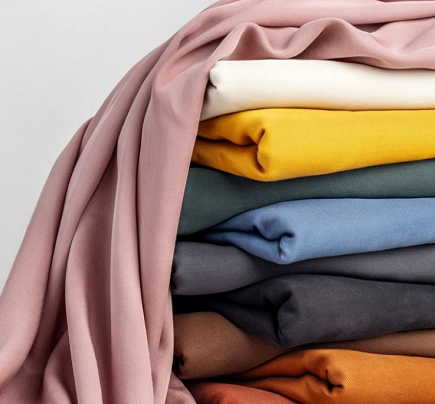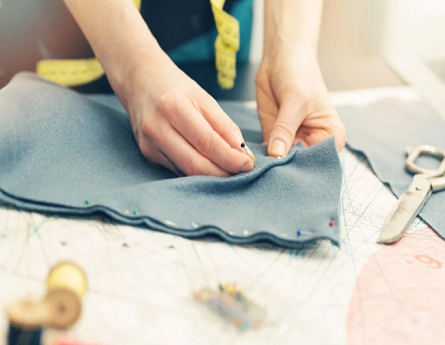Sewing with Viscose: Everything You Need to Know
 One of the greatest things about knowing how to sew is that it allows you to create garments that suit your body and style. Another awesome thing is that you get to choose the fabric you want your garment to be made from. Experimenting with different fabrics helps you discover what works best for your needs and sewing skills, allowing you to create beautiful pieces.
One of the greatest things about knowing how to sew is that it allows you to create garments that suit your body and style. Another awesome thing is that you get to choose the fabric you want your garment to be made from. Experimenting with different fabrics helps you discover what works best for your needs and sewing skills, allowing you to create beautiful pieces.
Have you tried viscose yet? If not, you should definitely consider giving it a try. At first glance, viscose may seem a little slippery to cut and sew. But if you use some pining, a sharp fine needle and some time and patience, you’ll be able to create some beautiful garments with it.
What is Viscose?
Viscose is a type of fabric for clothing that is neither natural nor synthetic – it’s something in between. It comes from a natural source, which is wood pulp. But in order to transform the wood pulp into fibre, it goes through a process where chemicals are used. Therefore, viscose is a semi-synthetic material.
Depending on the way it’s processed, viscose can be similar to silk, cotton, wool or linen. 100% viscose looks a lot like silk – transparent and glossy. Mixed with other fibres, it can have a glossy or matt finish, be heavy or lightweight or be textured or smooth.
What Can You Sew with Viscose?
Viscose is a versatile fabric that you can use in many sewing projects. Some of them include:
* Lightweight summer dresses: Ideal for creating breezy dresses that drape beautifully and keep you cool on hot days.
* Everyday tops and blouses: Soft viscose is perfect for making comfortable, stylish pieces you can wear daily.
* Skirts: Especially good for relaxed, flowy skirt designs that allow easy movement and all-day comfort.
* Formal eveningwear: Shiny satin-style viscose is a great choice for luxurious evening dresses and occasion wear.
* Relaxed pants and jumpsuits: Flowy, loose trousers or jumpsuits made from viscose offer the perfect blend of comfort and chic.
* Light accessories like shawls and scarves: Viscose chiffon is ideal for airy accessories that add a soft, elegant touch to any outfit.
* Beach tunics and kimonos: A great pick for lightweight, relaxed cover-ups that pair well with beachwear.
Types of Viscose Available
Like with other options of fabric for clothing, viscose is available in different types.
Twill
Twill means that the weave pattern consists of diagonal ridges. This type of viscose is airy, flowy and has amazing draping qualities.
Crepe
Viscose crepe is a little bit heavier than the standard version and also has a slight stretch to it. It’s a good option for making vintage-style dresses and blouses.
Marocain
Viscose Marocain is a particularly soft and airy type of fabric with a medium weight and great resistance. It is perfect for making summer tops, trousers and dresses.
Satin
A light-to-medium weight fabric with a gorgeous finish. It makes a great option for making luxurious garments on a budget.
Lawn
This could be the best viscose option to start sewing with. Although it is soft, it doesn’t move a lot, making it easy to handle no matter your skill level.
Georgette
Woven in highly twisted yarns, this type of viscose has a slightly grainy feel. These characteristics make it a very durable fabric, but it still drapes very well. Viscose georgette is a versatile material that can be used to make shirts, dresses, scarves and basically everything else. It’s also a great fabric for furnishing projects around the home.
Tips for Sewing With Viscose
As mentioned above, dealing with viscose for the first time may seem a bit challenging. Worry not! With the following tips, you’ll be able to achieve quite satisfactory results.
Pre-Wash the Fabric
Viscose is a fabric that tends to shrink, so make sure to pre-wash it. This will help ensure that your finished project fits as intended.
Wash the material in cold water using a gentle detergent. To avoid stretching, dry the fabric flat. Also, be careful not to wring it out to prevent distorting its shape.
Use the Right Cutting Techniques
The slippery characteristic of Viscose can make cutting it a bit tricky. One great way to ensure clean edges is to use a rotary cutter on a shelf-healing mat. To prevent the fabric from shifting while you cut, you can also tape a tissue paper to your cutting surface and pin the fabric on top.
Mark and Pin It
Marking the material will give you a visual guide while sewing. This will help you stay aligned even when the fabric shifts. Pinning will help keep the fabric pieces in place, reducing errors and uneven seams.
The best thing you can use to mark viscose is a tailor’s chalk or a disappearing fabric pen. Apply markings with gentle strokes to avoid dragging or distorting the fabric.
To prevent damaging the weave, choose silk pins or extra-fine glass head pins. Then pin within seam allowances to prevent visible holes in your finished garment. Pin every 2 to 3 inches to prevent slipping and shifting during sewing. If the viscose you’re using is very slippery, spray it with a light mist of spray starch and press. This will stiffen the fabric temporarily, making it easier to mark and pin.
Set Up Your Sewing Machine
Make sure you use a sharp needle; this will help avoid snagging. For lightweight viscose, you’ll want to adjust stitch length to about 1.5 to 2mm and for heavier fabric about 2.5mm.
When it comes to seams, the French type is ideal for viscose as it encases raw edges, hence preventing fraying. For long side seams, a lighting stitch or a narrow zigzag will provide the stretch and durability necessary.
Solving Common Sewing Issues
* Seam Puckering: Try loosening the bobbin thread tension and switching to a sharp needle. Test on fabric scraps first.
* Fraying Edges: Prevent fraying by overlocking the seams or applying a seam sealant.
* Fabric Slipping: A walking foot can help keep layers aligned, or place tissue paper beneath the fabric for more control.
* Fabric Stretching: Use stay tape to stabilise the fabric or opt for a lightning bolt stitch for stretch fabrics.
* Shrinkage Problems: Pre-wash your fabric before sewing to avoid post-sewing shrinkage.

